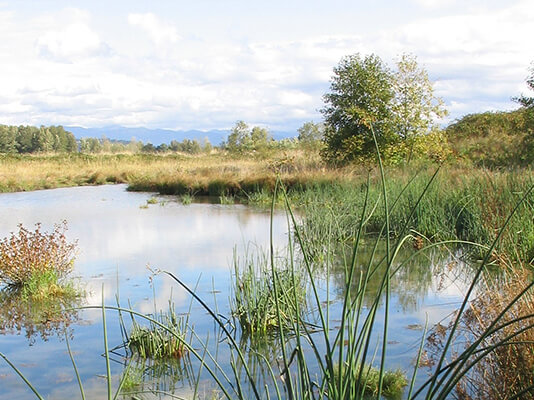 Funding is available through the Department of State Lands for projects that create, restore, or improve wetlands or waters.
Funding is available through the Department of State Lands for projects that create, restore, or improve wetlands or waters.
The State of Oregon has a goal of no net loss of wetlands or waters of the state. Projects that might impact these resources are required by Oregon state law to
mitigate for their impacts. When natural resource impacts are unavoidable, applicants need to compensate the state by helping create or restore wetlands or waters within the affected watershed. One compensation option involves paying into the DSL mitigation fund, money that is then made available as grant funds for projects that improve wetlands or waters.
Funding for eligible projects may be combined with available grants from other state and federal agencies, like the
Oregon Watershed Enhancement Board.
Applying for Mitigation Grants
The DSL mitigation fund provides financial support to projects that create or restore wetlands or waters within the same basin where other project impacts occur. Due to this, the availability of grant funds is often dependent upon whether in-lieu funds have been received from the applicable basin.
Below is a list of basins with current project funding opportunities. Projects in other basins will be considered as funds allow.
- Rogue Basin
- Hood Basin
- South Coast Basin
- Sandy Basin
- Umatilla Basin
Projects that will yield additional wetland acreage and functions are prioritized.
Projects are evaluated for grant funding based on whether they have a high likelihood of success and sustainability, a reliable water source, proven mitigation concept, and would require low maintenance after established. The design should focus on natural processes and native plant diversity. There should be no conflicts with adjacent land uses. Also, the project team should have capacity and demonstrated expertise. Finally, the landowner should support a permanent conversion of the land to wetlands or waters, so the project benefits Oregonians and the surrounding basin for years to come. For this reason, a deed restriction is required for the area being restored.
Preferred projects should meet the following standards:
- Result in net gain of wetlands and function.
- Target a natural resource conservation goal identified locally or regionally as an area priority or address a documented limiting factor in the watershed.
- Be located on a site with good habitat connectivity.
- Achieve numerous long-term environmental and social benefits (functions), like flood attenuation, supporting rare species, or water quality improvement.
- The area should have low level of threats from vandalism or invasive species.
- Provide a good cost to benefit ratio.
- The landowner should support a conservation easement with a qualified long-term steward (land trust, local government, special district, tribe, or other qualified party).
Projects may be submitted at any time. Contact a
mitigation specialist if you are interested in grant funding for a project and have any questions about funds available or eligibility of a project.
Then, submit an initial grant proposal that includes the following information:
- Applicant contact information.
- Project location (include a map and legal location).
- Landowner contact information and documentation that the owner is willing to provide long-term protection of the project areas.
- Anticipated arrangements for long-term management and stewardship.
- A brief description of the proposal, including existing site conditions and a conceptual plan for restoration, creation and/or enhancement of aquatic resources. Estimate acreage of existing wetland and post-project wetland areas. Include a labeled figure illustrating treatment areas. If the proposal includes preservation, describe the special qualities of the site and how they are threatened.
- A brief description of the anticipated net gains in wetland functions and other resource benefits expected as a result of the work.
- Expected timelines for project planning and implementation. Provide the current status of other grant applications, if any.
- A description of the capacity and expertise of the project team to implement the project and conduct monitoring. Include the qualifications and experience of staff, volunteers, partners, and consultants.
- A description of how the project complements existing or planned natural areas, conservation projects, or limiting factors in the watershed. Describe adjacent land uses and any compatibility issues.
- A draft project budget. Include estimates for pre-implementation planning, implementation (construction and vegetation establishment), monitoring and reporting (minimum five years), maintenance, and administration. Costs to acquire land or easements may be included as necessary, but acquisition alone does not qualify, unless preservation of existing aquatic resources is the sole action being proposed. Please note that expenses incurred before signing a grant agreement may not be reimbursable.
DSL staff will evaluate the project proposal and may conduct a site visit or consult with other agencies to confirm the project meets the selection criteria. If staff determine the project is a strong candidate for grant funding, you will be invited to develop a project plan.
If the project is approved, a grant agreement between DSL and the recipient will specify the roles and responsibilities, the project budget, deliverables to be reimbursed, performance standards, monitoring methods, and reporting requirements.